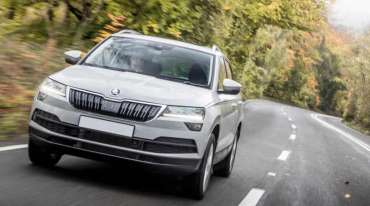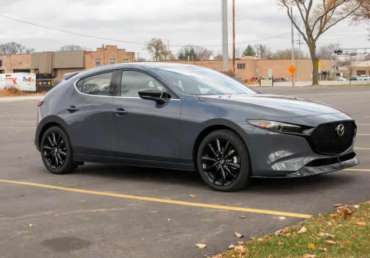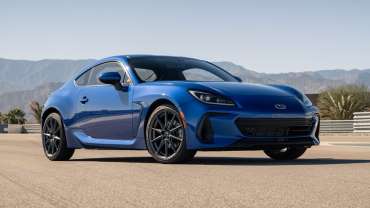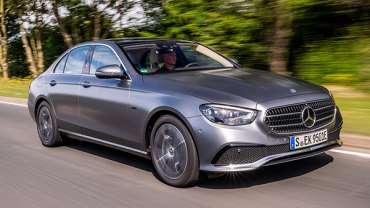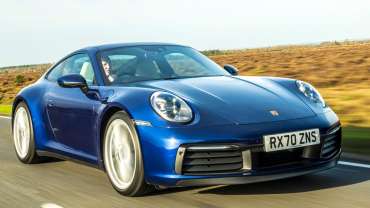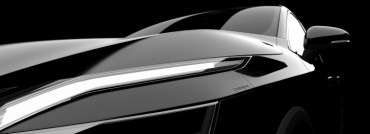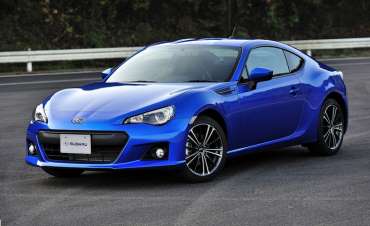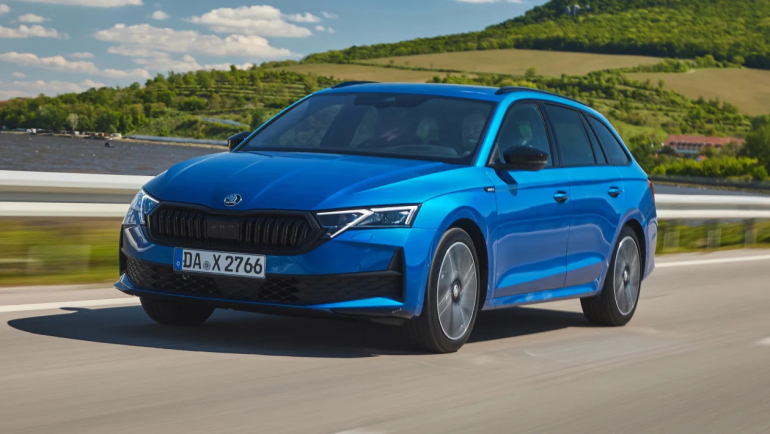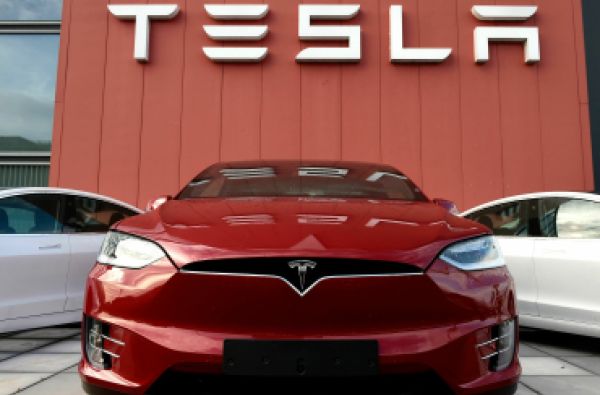
Worldcarblog.com
Skoda Karoq Review
If you want a well-built small SUV with plenty of space, the Skoda Karoq is well worth a look. Just don’t expect to be wowed by its design or the way it goes around corners.
The Skoda Karoq is the Czech brand doing what it does best – providing practical family transport with plenty of equipment and few fripperies. It’s comfortable, too, but you’ll have to look elsewhere if you want style and driving entertainment.
In short, it’s the knife and fork of the SUV world, dead simple and wonderfully effective.
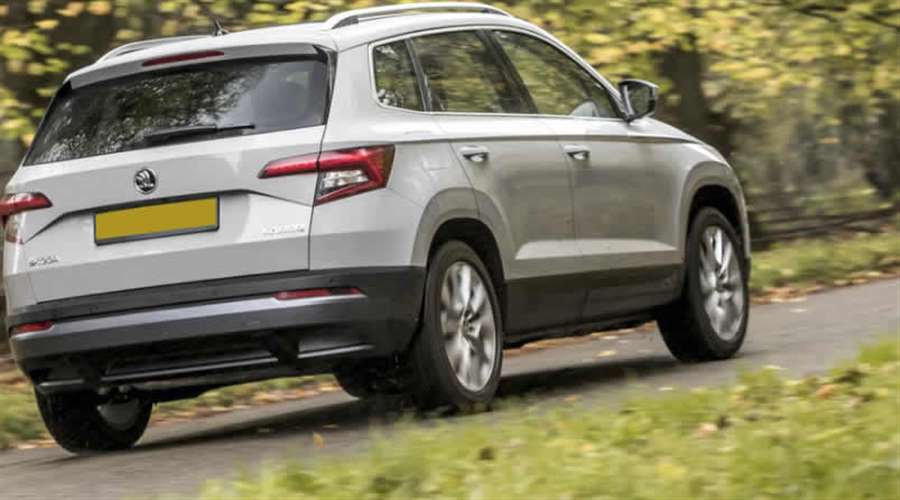
Having said all that, the Skoda Karoq is an excellent choice if you want a roomy small SUV with a raised driving position and a solid-feeling interior. As an added bonus, it comes with loads of clever features that’ll make it dead easy to live with.
The Skoda Karoq isn’t a car to shout about all its clever kit, though – it certainly doesn’t look as flashy as the sportier Hyundai Tucson and Kia Sportage. You do get some cool two-piece headlights like on the larger Kodiaq and the Karoq’s raised ride height means it’ll still tower over most conventional family hatchbacks in the school car park.
Step inside, and the Skoda’s sensible, staid theme continues – garish colours and oddly placed buttons just aren’t Skoda’s style. While this might mean the Karoq’s cabin isn’t particularly memorable, it does mean everything’s a doddle to navigate and use – including the standard 8-inch touchscreen infotainment system.
You’ll be sitting comfortably while you fiddle with the Skoda’s built-in gizmos, too. Every model comes with height-adjustable front seats to help you get settled and there’s absolutely loads of space for tall adults to stretch out.
The Skoda Karoq’s sliding rear seats and wide cabin mean three adults won’t feel like tinned sardines in the back and the boot’s roomy enough to carry everything you need for a family week away. It’s easy to load and you can even remove the back seats in high-spec cars to carry some seriously bulky loads, just like in a van.
The Skoda Karoq is a no-frills family SUV with a very practical cabin and a range of sensible, economical engines.
Mat Watson, carwow expert
That said, the Skoda Karoq drives much better than any van ever will. Entry-level SE models have comfy suspension that only jars over sharp bumps and the cabin is quiet at a cruise – save for a little bit of wind noise coming from the door mirrors.
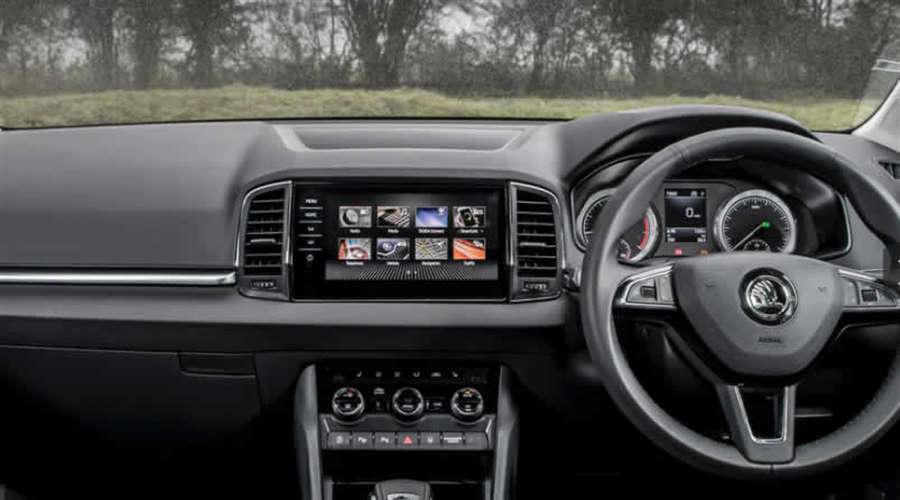
You won’t notice any of this around town, but the slightly jerky automatic gearbox can start to frustrate when pulling out of junctions and parking in town.
Stick to the standard six-speed manual and one of the Skoda Karoq’s smaller petrol engines though, and it feels right at home nipping to the shops or pottering along urban streets.
If motorway journeys are more your thing, a diesel will be more economical and you’ll want to consider the optional adaptive cruise control that’ll accelerate, brake and steer to keep you in lane.
All this makes the sensible Skoda Karoq one of the safest and most practical small family SUVs on sale. It’s well worth seeing how much you can save by checking out our Skoda Karoq deals, then.
Common Skoda Karoq questions
What does Karoq mean?
Kodiaq, Karoq, Kamiq… you see the theme here – Skoda names its SUVs starting with the letter K and ending with the letter Q.
The origins of the Karoq name goes deeper than that, however. The name is derived from Alutiiq – a native Alaskan language. Karoq is a combination of the terms ‘KAA’RAQ’ (car) and ‘RUQ’ (arrow – an arrow is part of the Skoda logo). Hence Karoq.
Is the Skoda Karoq 4-wheel drive
The Skoda Karoq can come with four-wheel drive. The 2.0-litre 190hp petrol and the 2.0-litre 150hp diesel are 4×4 cars. And remember, the chunkier Karoq Scout model is only available as a 4×4.
Where is the Skoda Karoq made?
The Skoda Karoq is made at Skoda’s main plant in Mlada Boleslav alongside the Octavia, Fabia, Scala and the new Kamiq SUV.
How practical is it?
The Skoda Karoq has a big boot and space inside for four tall adults. The VarioFlex back seats can slide and recline individually, or be removed for a huge load bay
Skoda Karoq interior
The Karoq’s cabin might not be particularly exciting to look at but it feels sturdy and all models get a slick 8-inch touchscreen infotainment system as standard
Style
The Skoda Karoq’s interior is logically laid out, solidly built and packed with useful features.
Expensive-feeling soft-touch plastics are used for the top half of the dashboard and the doors, and although the lower half of the dashboard’s plastics aren’t soft they don’t look cheap.
The large glovebox lid feels robust and opens with a damped action, you get flashes of chrome and reasonable looking trim pieces that brighten up the interior. The only black mark in terms of quality is the cheap-looking plastic used for the lower half of the doors.
Even entry-level cars get an 8-inch colour touchscreen with clear graphics which does wonders for adding a bit of a high-tech air to the Karoq’s cabin.
SE models have chrome door handles and chrome surrounds for the air vents that give them a classier look than an equivalent Nissan Qashqai. The Karoq comes with attractive dark cloth upholstery that should hide bad stains very well. SE L models are worth considering though because they come with suede-effect upholstery that looks and feels expensive.
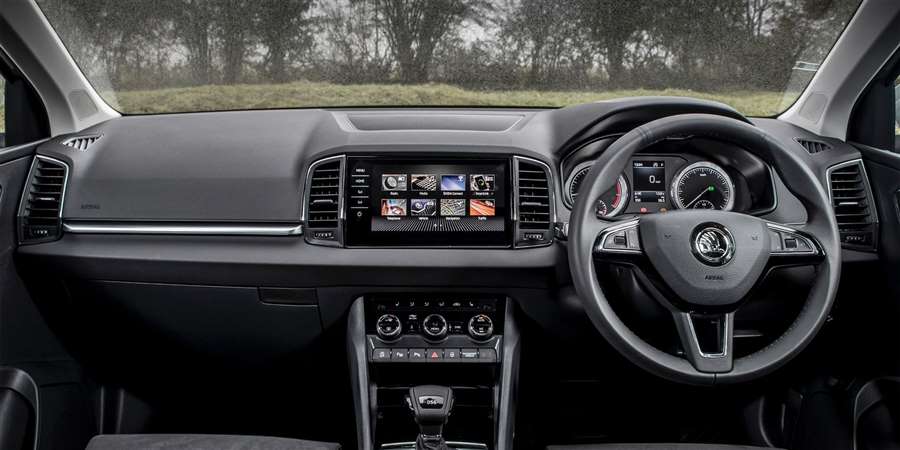
In fact, it’s nicer than the leather you get in Edition models, although the latter should be a lot easier to keep clean. Edition models also get lights that illuminate the sides of the car at night – so you don’t hop out into puddles – and ambient lighting that makes the interior look prettier at night.
If you fancy something a bit sportier, there’s also the aptly named Sportline model. These versions come with more supportive front seats with some contrasting silver trim, a set of aluminium pedals and a posher leather-trimmed steering wheel.
Infotainment
Even the entry-level SE Karoq comes with an 8-inch touchscreen that’s smart looking and easy to use.
It’s actually slightly easier to operate than the upgraded system because it has a couple of large knobs for volume and scrolling in and out of maps.
Sat-nav doesn’t come as standard, but you do get Android Auto, Apple CarPlay and Smartlink so you can use the navigation apps on your compatible smartphone via the Karoq’s big screen. It’s such a good system that you’ll not miss having integrated sat-nav and it also makes it easier to access your phone’s contact list and play music.
Mid-range SE L models’ infotainment screens look exactly the same but do come with Skoda’s own sat-nav system. Its graphics are slightly more detailed than the ones you get when you use your phone, but your phone’s sat-nav is better because it can route around congestion.
Edition models are the only ones to come with a 9.2-inch sat-nav screen that has a faster processor – although loading times are quick enough on the other systems – and a higher-resolution display.
Its touch controls – for volume and map scrolling – are trickier to operate when you’re trying to concentrate on driving, but on the plus side, they give the system a pretty, glassy appearance that looks a fair bit posher than the cheaper screens. It also gets gesture control – so you can wave your hand to scroll through menus, but its unresponsiveness means it isn’t worth the extra cash.
Source: carwow.co.uk
2021 Mazda3 Turbo: More Appealing, Still Niche
The verdict:
Endowed with the model’s first turbocharged gas engine since the Mazdaspeed3 left showrooms early last decade, the 2021 Mazda3 can muscle past slower traffic with little effort — a commanding, if reserved, degree of performance that should raise the car’s appeal among Mazda fans. Still, broader obstacles remain for mass-market audiences.
Versus the competition:
The Mazda3 is among the most fun-to-drive cars in its class, and a new engine only furthers that strength. But for daily driving, many competitors are easier to live with.
As before, the 2021 Mazda3 is available as a sedan or hatchback, with standard front-wheel drive or optional all-wheel drive. Last year’s four-cylinder engine carries over for most models, but Mazda bookends it with two new ones: a smaller four-cylinder in base trim sedans, and the turbocharged four-cylinder in high-end sedans and hatchbacks.
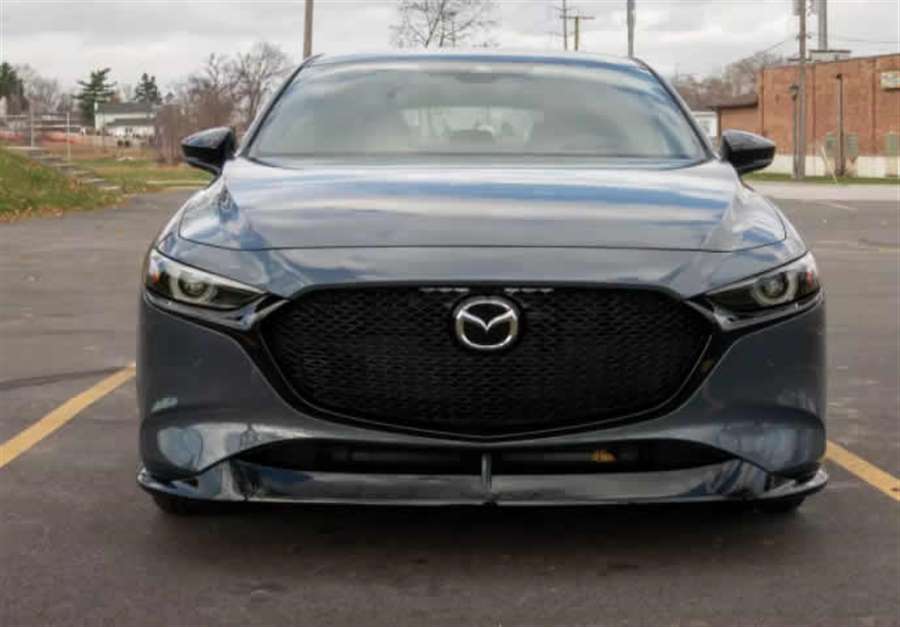
Seven trim levels (base, S, Select, Preferred, Premium, Turbo and Turbo Premium Plus) run the gamut from the low-$20,000s to the mid-$30,000s with factory options; automatic transmissions come on all except the Premium hatchback, which is available with a manual. Stack the gang up here, or compare the 2020 and 2021 Mazda3 here.
We drove a Mazda3 Turbo Premium Plus hatchback, though we’ve also evaluated the current generation, both in sedan and hatchback form, with the mid-level engine.
Powered Up
Although we haven’t tested the base engine, its limited availability means just a sliver of shoppers will buy it. Most Mazda3 examples are likely to have the 2.5-liter four-cylinder, which was the only engine available in the 2019-20 Mazda3. It’s a capable, smooth-revving engine, though tall gearing from Mazda’s six-speed automatic transmission limits some of its potential. Accelerate from a stop up to highway speeds, and it’s a long climb through 2nd and 3rd gear — but if you hit the gas while already in motion to tack on more speed, the same automatic readily downshifts without undue delay. You hate it, you love it.
I’ll get to the turbo four-cylinder in a moment, but first some context on how it stacks up:
- 2.0-liter (FWD base sedan only): 155 horsepower, 150 pounds-feet of torque; six-speed automatic only
- 2.5-liter (FWD or AWD, sedan or hatchback, most trim levels): 186 hp, 186 pounds-feet of torque; six-speed manual or six-speed automatic
- Turbocharged 2.5-liter (AWD only, sedan or hatchback, Turbo or Turbo Premium Plus trims): 250 hp and 320 pounds-feet of torque (using 93-octane premium gas) or 227 hp and 310 pounds-feet of torque (using 87-octane gas); six-speed automatic only
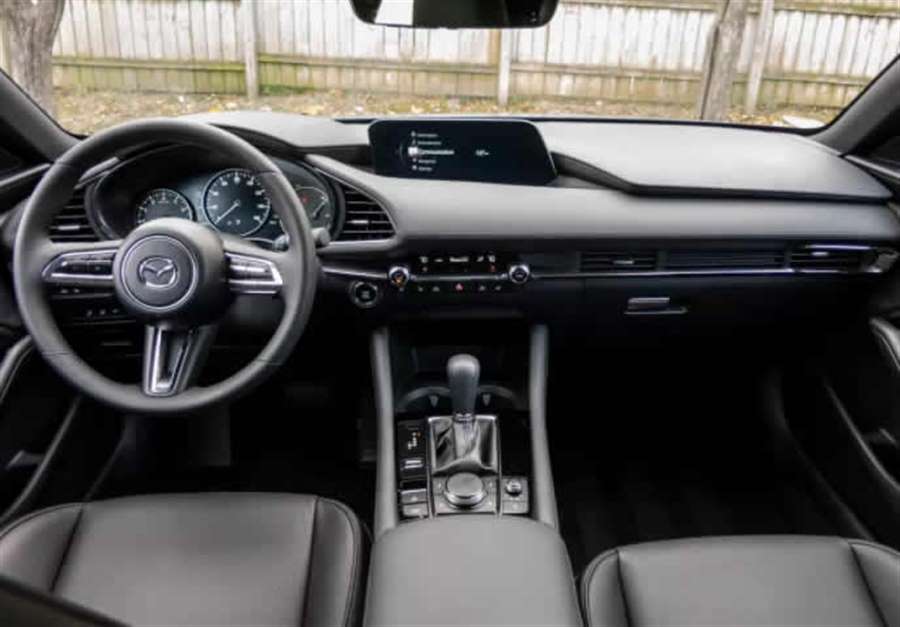
Our test car came filled with 93-octane premium fuel, according to the fleet company that dropped it off. In any case, the drivetrain behaves in some respects like a diesel engine, with torque aplenty for vigorous starts but modest power progression once you get past 4,000 rpm or so. It’s not quite a plateau — some additional power still comes if you rev it out — but the drivetrain feels best suited to muscle past slower traffic as you apply steady gas, as opposed to flying around near redline with your foot to the firewall. Accelerate while already in motion and the transmission resists downshifts notably more than with the non-turbo 2.5-liter, but the Mazda3 Turbo’s vast torque and responsive accelerator absolves it.
Ride and Handling
Our impressions from when we first drove the current-generation Mazda3 still stand, which is to say ride quality is polished but firm. Although the suspension employs a cheaper torsion beam setup in back — as opposed to the independent rear suspension offered on previous generations of the Mazda3 — the chassis maintains good body control and clean, reverb-free shock absorption. But tuning is decidedly firm and probably more than what most compact-car shoppers will tolerate. Mazda cites a retuned front suspension with stiffer springs for the Turbo, and it does little to change the car’s character; softer-riding rivals like the Nissan Sentra, Toyota Corolla and Volkswagen Jetta seem better suited for the daily grind. The Mazda3 improves on the Honda Civic’s perpetual bounciness, but that isn’t saying much. Mazda shouldn’t wait for a full redesign to revisit suspension tuning.
Like the Civic, the Mazda3 redeems itself on the handling front, perhaps even more so in the Turbo. Mazda claims the AWD system on Turbo models can distribute more torque to the rear wheels, and the car indeed feels more neutral around sweeping corners than its non-turbo sibling. You can slide the tail a touch with aggressive mid-corner gas, something the non-turbo Mazda3’s AWD all but prohibited, and understeer remains well contained throughout.
Mazda claims retuned steering hardware for sharper response on all Mazda3 variants for 2021. The ratio still isn’t as quick as some rivals’, but feedback remains very good. Flinging the Mazda3 around cloverleaf sweepers is a lively, communicative experience — an increasingly rare quality these days, even among sporty cars.
Interior and Tech
Cabin materials in the well-equipped Mazda3 we evaluated were exemplary for this class. Mazda’s optional leather upholstery would feel at home in any entry-level luxury car — cloth and leatherette (imitation leather) are also available — and generous padding covers the armrests and areas your knees touch. Controls feel meticulous all around, and most surfaces — save a low-budget headliner — appear universally rich. Impressively, the backseat sees little drop-off in materials quality, a widespread practice among Mazda’s rivals.
In contrast to all that, the Mazda3’s multimedia system remains a weakness. It constitutes a high-mounted dashboard screen measuring a healthy 8.8 inches diagonally, but the ultra-wide aspect ratio limits overall display size with just 3 inches of screen height. Apple CarPlay and Android Auto come on all but the base sedan, and CarPlay leverages the screen’s full width, but the backup camera does not. What’s more, the screen isn’t a touchscreen — not that such functionality would help much, as it’s mounted too far forward to easily reach — and requires a knob-based controller behind the gear selector. For straightforward user-friendliness, that’s a step backward; the related Mazda CX-30 SUV has the same system, and it ranked last for usability of controls in a recent four-car comparison we conducted.
Seating and Cargo Space
Craftsmanship notwithstanding, the Mazda3 isn’t particularly roomy or easy to see out of. The driver’s seat sits relatively low to the ground, and larger drivers will no doubt find the space narrow between the center console and doors. The hatchback blocks over-the-shoulder views with giant roof pillars and a tiny rear window; the sedan has mercifully thinner pillars, though rear glass is still undersized.
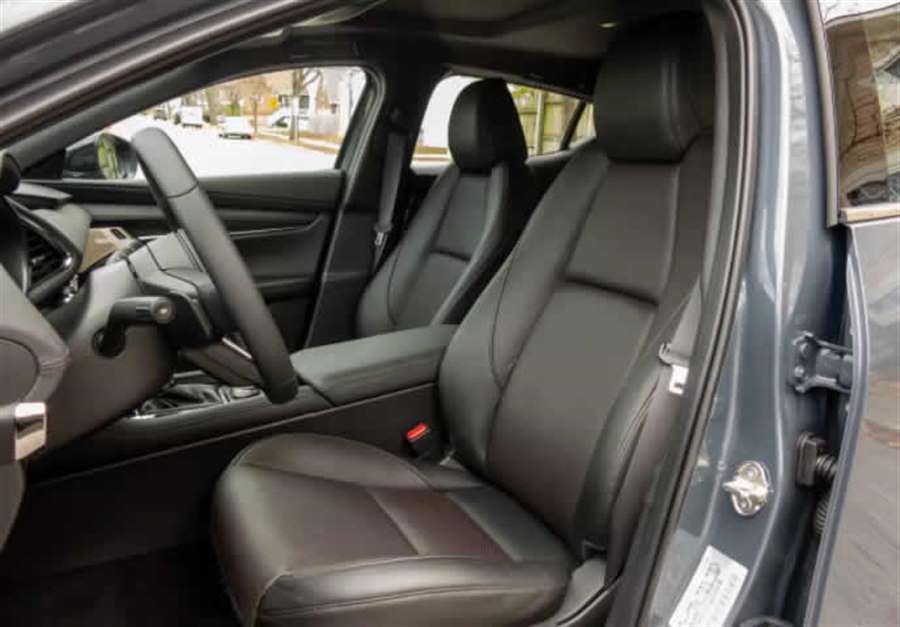
Backseat knee clearance is tight, and we measured a modest 13.1 cubic feet of cargo volume behind it. That’s through Cars.com’s independent cargo measurements, not manufacturer-advertised specs, which we’ve found unreliable. Versus the Mazda3 sedan, the hatchback carries inherent advantages to maximizing cargo space when you fold the backseat down, but for those who need to carry passengers and cargo, the sedan may have considerably more room. Although we didn’t have access to a 2021 model-year sedan to measure cargo space with our latest methodology, we found the current-generation sedan’s trunk roughly a third deeper than the hatchback’s cargo area — with similar width and height to the tops of the seatbacks — when we tested both body styles two model years ago. (There is more space above the backrests in a hatchback, but loading above this height compromises cargo containment and rearward visibility, both safety hazards.)
That’s not surprising. Indulge me a minute on this: Manufacturer-stated cargo specs usually employ separate methodology between hatchbacks and sedans, rendering spec comparisons tenuous at best. The Mazda3 hatchback isn’t necessarily an outlier, with as-tested cargo volume similar to that of most entry-level SUVs in our recent comparison. But you’ll find more cargo volume in many sedans, and less in many hatchbacks and SUVs, when measured the same way — which is to say, up to the tops of the seatbacks. With apples-to-apples methodology, the current Civic, Sentra and Corolla sedans have some 40-50% more usable cargo volume than a Mazda3 hatchback.
Should You Buy a Mazda3?
With the base 2.0-liter four-cylinder, the Mazda3 starts at $21,445 with destination, which is competitive for the class. Standard features include the automatic transmission, 16-inch alloy wheels, one-touch power windows all around and the 8.8-inch multimedia system, albeit without CarPlay or Android Auto. Also standard are stop-and-go adaptive cruise control, lane departure warning with steering assist, and forward collision warning with automatic emergency braking. The well-rated AEB helped the 2020 sedan and hatchback both earn top ratings from the Insurance Institute for Highway Safety, but IIHS has yet to publish ratings for the 2021 model as of this writing. When available, the 2021 report and its changes, if any, can be found by searching for “Mazda 3” here.
Higher trim levels, including all hatchbacks, all have the smartphone integration and 2.5-liter engine. Spend more and you can get heated leatherette or leather seats, a moonroof, dual-zone climate control, a power driver’s seat and Bose premium audio. Newly optional for 2021 are rear automatic braking, a 360-degree camera system and Traffic Jam Assist, a low-speed lane-centering steering system that’s now here following availability overseas.
Those who want the Mazda3 Turbo will shell out at least $30,845 for the sedan, with the hatchback running another $1,000. Turbo models with the Premium Plus addition (leather, Traffic Jam Assist and the safety extras, in-dash navigation and more) edge close to $35,000, with prices spiraling past that once you add premium paint and various cosmetic enhancements. That kind of money falls somewhere between performance mass-market compacts and entry-level luxury sedans.
As such, there’s a Mazda3 for many performance thresholds. A few years into its fourth generation, Mazda’s least expensive car remains a fun-to-drive choice among compact sedans and hatchbacks. The turbo engine extends the spectrum, though it doesn’t change the nameplate’s limited appeal for left-brained shoppers. As I said when the current generation arrived on scene for the 2019 model year, the Mazda3 seemed destined for niche appeal. The Turbo does much to add appeal — less so to expand the niche.
Source: cars.com
2022 Subaru BRZ First Ride: Shotgun in the New Sports Car!
Even if it ain't broke, there are a few things you can still fix.
Since its debut in 2012, the Subaru BRZ has focused on delivering great handling. We've heaped piles of praise upon it—and rightly so. Small, light, agile, great suspension, great balance, low price, the ability to carry four tires with the rear seats folded flat—those are the ingredients that make up a great sports car. Remember, we put it one place ahead of a McLaren (and way ahead of a Lamborghini) at the 2012 Best Driver's Car.
That out of the way, the Subaru BRZ has long had two flaws. One, the design was a missed opportunity. Front-engine, rear-drive coupes lend themselves naturally to sleek, sexy shapes (Jaguar E-Type, Shelby Cobra, Datsun Zs, almost every Aston Martin ever built). Sadly, the first-generation BRZ had weird headlights, fake vents, and a softness to the rear end that allowed onlookers to wrongly assume it was front-wheel drive.
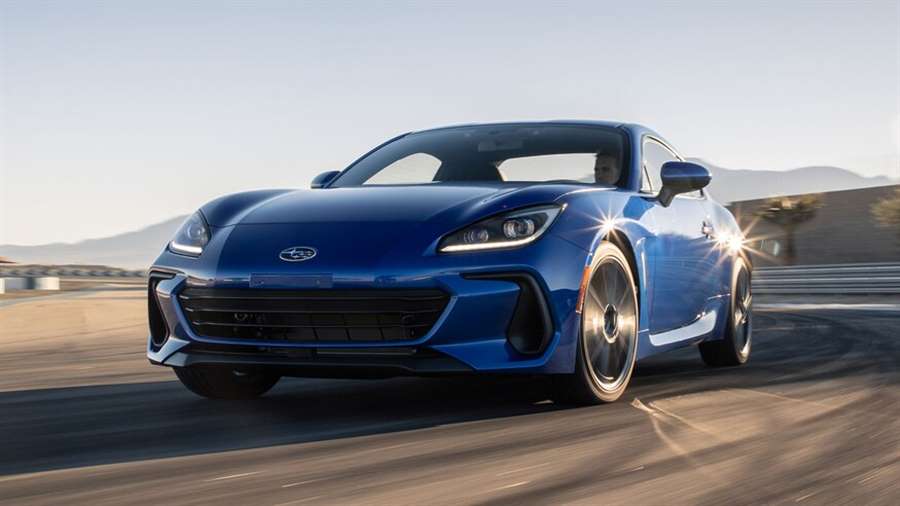
The other issue was of course power—or lack thereof. Case in point: Two years ago, Subaru released the 2018 BRZ tS, a car the brand claimed was "pure handling delight." I just reread the review I wrote of that one, and the salient point is: "I've never met anyone who has driven a BRZ … and asked for more handling. All anyone has ever said is 'More power.' As in, can we please have more power?" As you may have guessed, the answer was no. Well, guess what?
Meet the 2022 Subaru BRZ. Not only is the car all new, but so is the sheetmetal. Better yet, it has more power! Let's start with all 28 extra horsepower. The engine remains naturally aspirated but grows from 2.0 to 2.4 liters. The first-gen BRZ had the Subaru WRX's engine with the turbocharger removed, whereas the new car has the Ascent's 2.4-liter flat-four sans turbo. The result is 228 horsepower at 7,000 rpm and 184 lb-ft of torque at 3,700 rpm, up from 206 hp and 156 lb-ft of torque in manual transmission cars and 200 hp and 151 lb-ft of torque in automatics. Why no turbo? Subaru says to keep the BRZ's price down. That's probably most of it, though you have to assume that to some degree Subaru is protecting the WRX. The same theory applies to Toyota's safeguarding Supra turbo-four sales with its 86 assembly-line cousin.
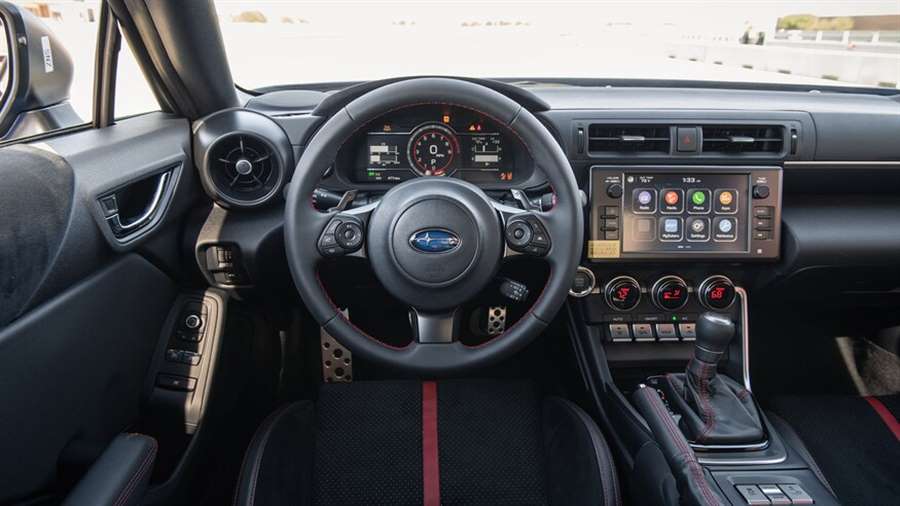
In the Age of Hellcat, the BRZ no doubt sounds underpowered. Keep in mind, however, that Subaru says the new BRZ weighs less than 2,900 pounds, which would be about 100 pounds more than the last one we weighed, a 2016 Series.Hyperblue that checked in at 2,763 pounds. Do the math, and the weight-to-power ratio still improves by over a half pound per horsepower on the new car. You can have your 2022 BRZ with either a six-speed manual or a six-speed automatic. Why still a six-speed auto? Remember that Subaru relies on Toyota's huge profits and massive supply chain to get the BRZ and Toyota 86 built. Toyota supplied the project with a six-speed Aisin slushbox. As ever, get the manual.
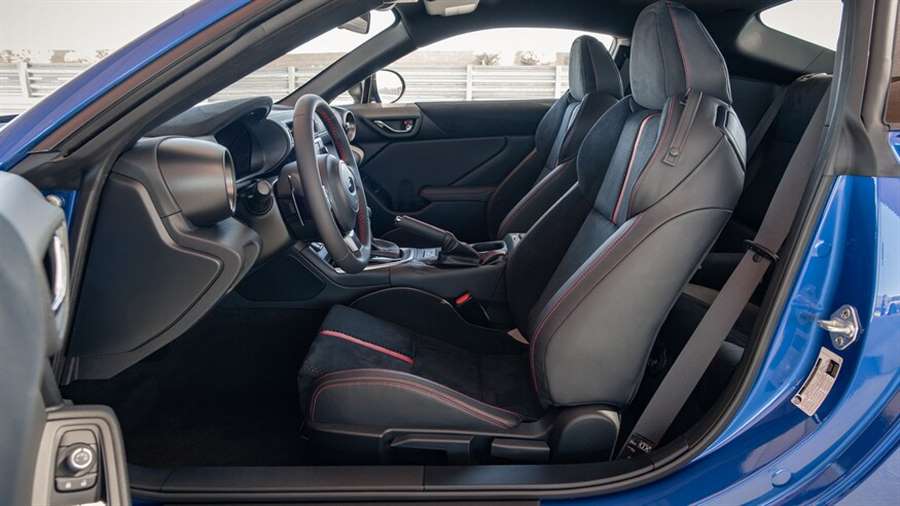
As for the chassis, it's all new, though Subaru built it with lessons learned from the brand's Global Platform. The top of the boxer engine block sits lower than the top of the tires, and as such, the center of gravity remains quite low. The front suspension is made up of long-travel MacPherson struts and coil springs, whereas the rear brings dual control arms and coil springs. A classic, sporty recipe for sure, and identical in setup to the previous car. The BRZ has grown fractionally in terms of wheelbase (101.2 inches to 101.4 inches) and length (166.7 inches to 167.9 inches) but is unchanged in width (69.9 inches), and the new one is actually shorter in height than the car it replaces (52.0 inches versus 51.6 inches). There are five driving modes, and if you place the stability control in Track mode, the digital tachometer reconfigures itself into a line graph just like a Mustang or a McLaren 570S.
As for the looks, I think the 2022 Subaru BRZ is a big improvement over the old car. From the front there's a bit of a mini-Corvette vibe happening, in a good way. Those black, penguin-shaped things below the headlights are functional vents that provide cool air, while heat generated up front exits via functional side vents just in front of the doors. The new BRZ almost looks like its smiling, a Mona Lisa sort of vibe. The headlights are a massive improvement from the last version. A little bit of Mazda? Sure, but Mazdas are by and large great looking. For you design nerds out there, the new BRZ loses a degree or two of tumblehome, the idea being that doing so would make the fenders look more square and therefore tougher. I think it works. I actually see a bit of Infiniti Q60 in the side profile, minus that car's terrible C-pillar. From the rear, I'm seeing a nice mashup up of a Honda Civic and Aston Martin Vantage, largely because of that kicked-up, mini-ducktail spoiler. You know what? It all works.
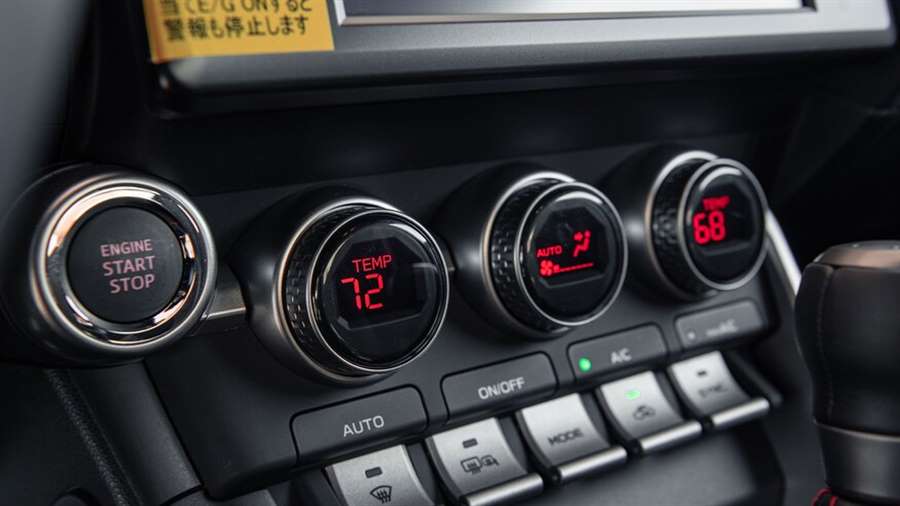
How's the 2022 Subaru BRZ drive? Dunno. Despite (a bit of) begging, I wasn't allowed to drive the car. Why not? Dunno, again. However, Subaru was nice enough to trek former F1/NASCAR and current Subaru rally driver Scott Speed out to the Thermal Club near Palm Springs to give yours truly some hot laps. "It's my mission in life," Speed said, "to get a one-make race series going with this car." His reasoning is sound. Although it's not a drag racer, 0-60 mph should happen in the low 6-second range. More important, not only is peak torque up, but from the seat of my pants, the torque curve is also up throughout the rev range. Unlike in the previous car, it felt as if the 2022 BRZ was blasting out of corners. In the first-generation BRZ, well, you never felt that. Is that notorious flat spot in the middle of the rev range gone? Again, didn't drive it, but it feels like it's mostly gone, not totally gone. The new BRZ felt as balanced and as neutral as ever, with a hint of oversteer on turn in. Understeer basically doesn't happen, due mostly to the suspension tuning, though I'd guess the sticky Michelin PS4S tires help some, too.
Speed's reasoning for the racing series is that modestly powered sports cars like the BRZ will result in more of a pack or group on the track, and that will allow for more passing opportunities, and passing is more fun than not. The new BRZ is the perfect tool for the job because it behaves so well on the track. Who am I to argue with Mr. Speed?
Subaru hasn't announced pricing yet, but expect it to be in line with current BRZ prices when the new sports car goes on sale this fall, so just a hair under $30,000.
Source: motortrend.com
2021 Mercedes-Benz E 300 e EQ Power AMG Line Premium First Review
The E-Class’s mid-life facelift is limited to a few minor styling changes and some tweaks to the cabin, but it remains an all-round impressive package. It’s still not as sharp as a BMW 5 Series to drive, but the interior blows its rival out the park; some of the tech feels like a bit of a gimmick, but quality, fit and finish are second to none. The E-Class now offers true S-Class luxury at a fraction of the price.
Executive saloons are consistently popular with UK car buyers and still take a sizeable slice of the new car market. However, the sector is changing, with many buyers and fleet managers turning away from diesel in favour of plug-in hybrid drivetrains.
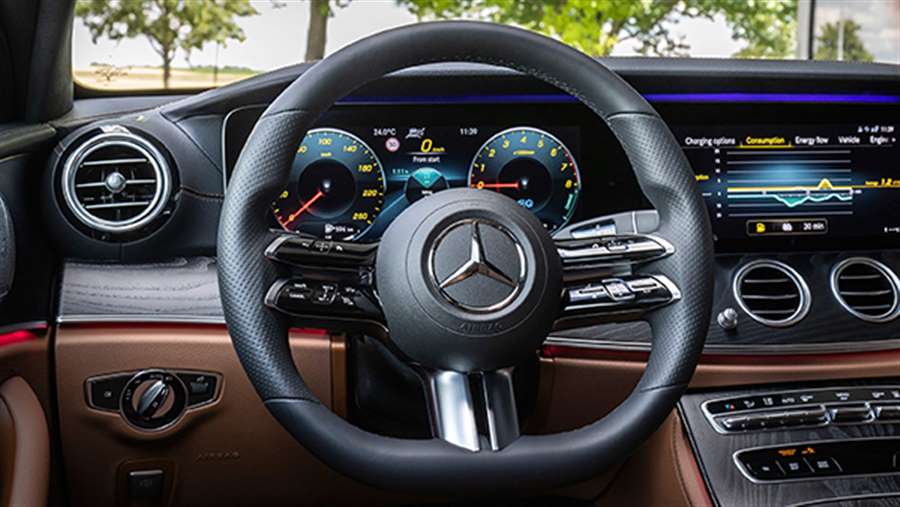
Therefore it’s fitting that our first taste of the facelifted Mercedes E-Class comes in the shape of the E 300 e plug-in. The revisions are limited to a handful of cosmetic tweaks and cabin upgrades with revised infotainment, but the 300 e’s engine and electric motor have been left well alone.
The new infotainment system is an improvement, thanks to the updated and responsive touchpad; Apple CarPlay and Android Auto are both included, and are much more intuitive to use now that the screen can be operated via touch.
The upgraded cabin also features a new steering wheel, with two pairs of thin spokes branching out from the hub. They’re festooned with buttons, which is slightly confusing at first, but no hardship once you’re familiar with it. It also features ‘capacitive hands-off detection’ for use in conjunction with the adaptive cruise control, which includes route and road-based speed adjustment.
The E-Class’s overall feeling of quality is impossible to ignore. From the plush seats to the leather-trimmed doors and centre console, it’s hard to see where Mercedes’ new S-Class flagship will improve on the E-Class’s winning formula. The cabin is perhaps less driver-focused than that of a BMW 5 Series, but you can’t argue with the faultless fit and finish.
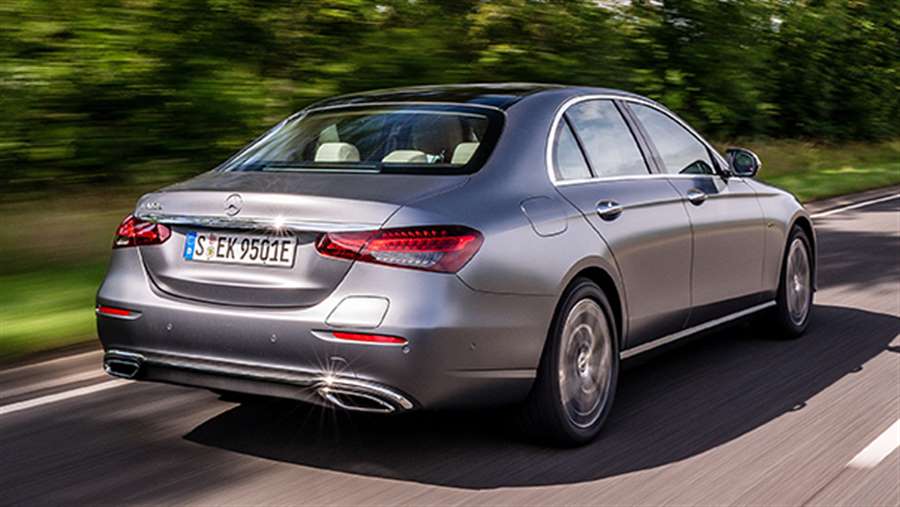
Every E-Class bound for the UK gets twin 12.3-inch digital screens as standard; previously, entry-level cars used a set of analogue dials paired with a large central infotainment display. New LED lights also feature, alongside 17-inch alloys, heated leather seats and a suite of safety kit.
If you’re after the sharpest-handling executive saloon, then the 5 Series still edges the Merc, while the latest Audi A6 arguably pips it for involvement, too. The E 300 e wafts along in a way the BMW can’t, yet it can feel disconnected from the road at times; fine on the motorway, but less engaging on a twisting country road.
The upside of this is that the Mercedes rides well at high speeds – especially on our car’s 18-inch wheels. It’s not perfect around town, but driver and passengers are shielded from the very worst lumps and bumps. Smaller potholes are of little concern, and even larger ones are absorbed with reasonable confidence.
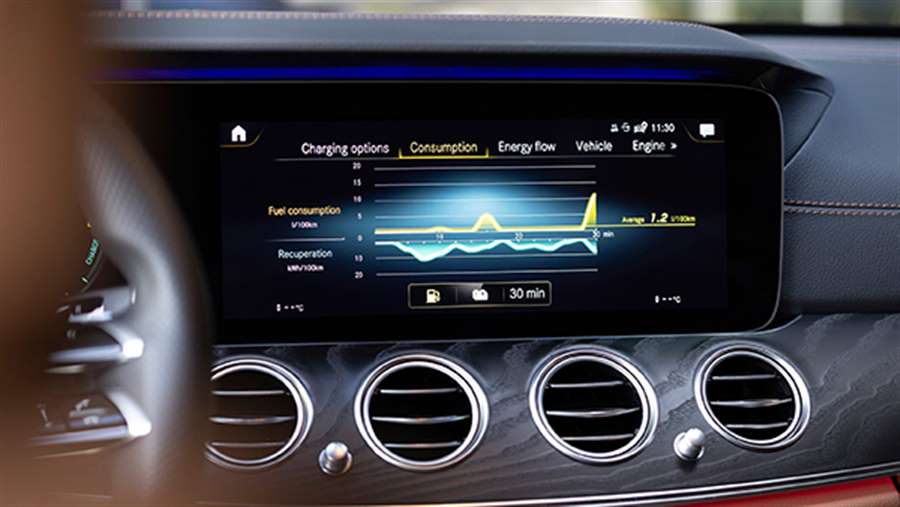
With no changes to the hybrid model’s powertrain or chassis, the E 300 e retains its 2.0-litre four-cylinder petrol engine and electric motor. Combined they produce 316bhp and an impressive 700Nm of torque. As such, performance isn’t lacking; the electrical system’s instant torque allowing access to all that power from a standstill.
Despite its prodigious output, the four-cylinder motor can sound a little strained when you floor the throttle and extend it into the upper rev range. Still, the E-Class more than makes up for this with its incredible refinement – especially when running around on electricity.
Mercedes still claims an electric-only range of around 32 miles on a full charge, and our test drive showed this is a realistic estimate. Even on faster roads, the E-Class’s range read-out dropped very nearly in line with actual mileage covered. The various drive modes allow you to prioritise or hold battery power, or let the system work out what’s best for maximum efficiency.
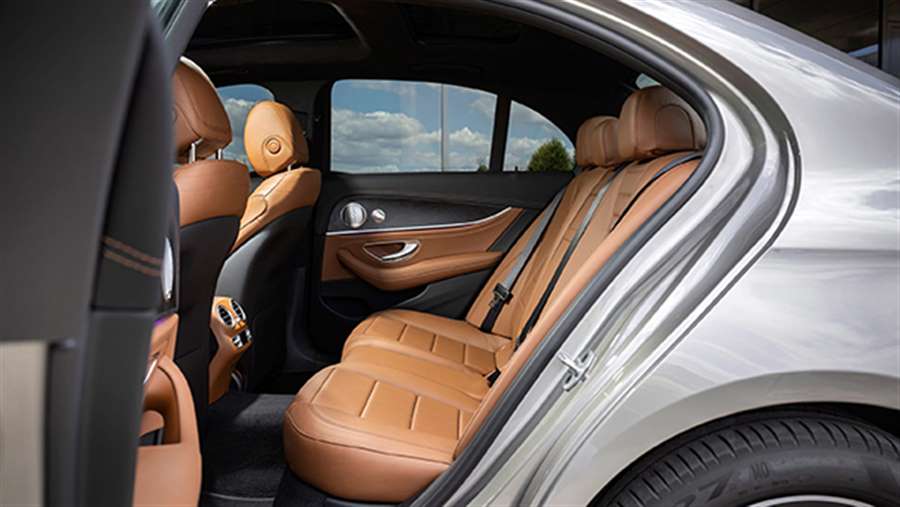
The transition between petrol and electric power isn’t perhaps quite as smooth as it could be, but you’re unlikely to notice the car switching between the two in normal driving. We’d recommend using the battery hold function as much as possible; there’s nothing quite as satisfying as running around town on electric power alone – especially at the end of a long journey.
Charging the E-Class plug-in hybrid is pretty straightforward, thanks to the fact that every E 300 e comes with two cables – one to use with a wallbox or at public charge points, and one for standard three-pin domestic sockets. Owners using the latter are able to top up the battery in around five hours, or just 90 minutes using a 7.4kW home wallbox. There’s no option for high-speed CCS rapid charging, though.
One thing to take into consideration is that the battery does eat into boot space quite significantly, reducing the overall capacity by 100 litres to 370 litres.
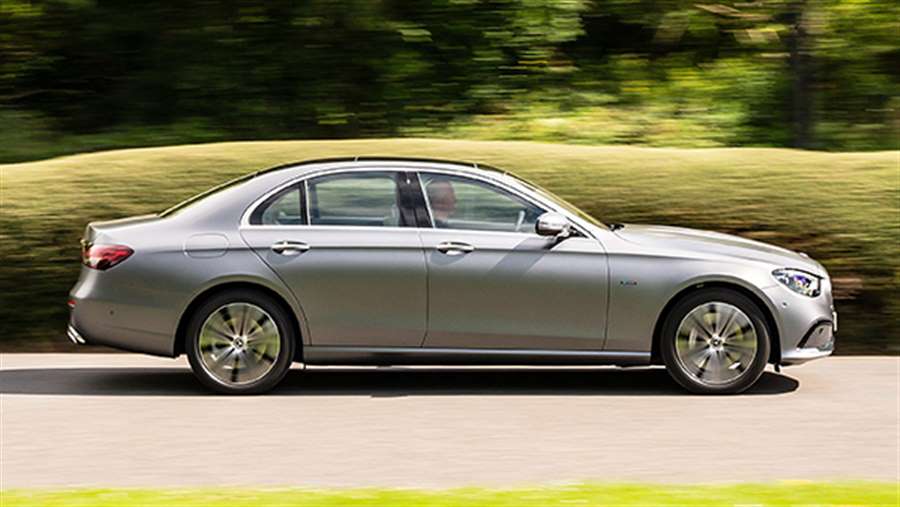
Of course, the main reason many buyers will opt for a plug-in hybrid over a diesel is for the generous tax breaks. The plug-in car grant no longer covers PHEVs, but the E 300 e’s low CO2 emissions mean company car drivers can take advantage of an appealing Benefit-in-Kind rating of 10 per cent for the current tax year. In this regard, an E 220 d can’t come close, although the E 300 de diesel plug-in will hold even greater appeal than the petrol for high-mileage drivers. Read more > https://mercedes-world.com/e-class/mercedes-benz-e300e-amg-review
Source: mercedes-world.com
New Porsche 911 Carrera S manual 2020 review
We find out if the new Porsche 911 Carrera S with a seven-speed manual is the driving enthusiast's choice
Verdict
Objectively, the 911 Carrera S makes little or no sense whatsoever with a manual gearbox, even though the new seven-speed transmission is listed as a no cost option. The car is slower, burns slightly more fuel and is fractionally more polluting than its dual-clutch automatic equivalent. Yet subjectively, it is more engaging, more fun, and more 911 with three pedals, despite the shift itself still not being perfect. In the end it’s the buyer that makes the choice, but for us the manual is now the more appealing sports car.
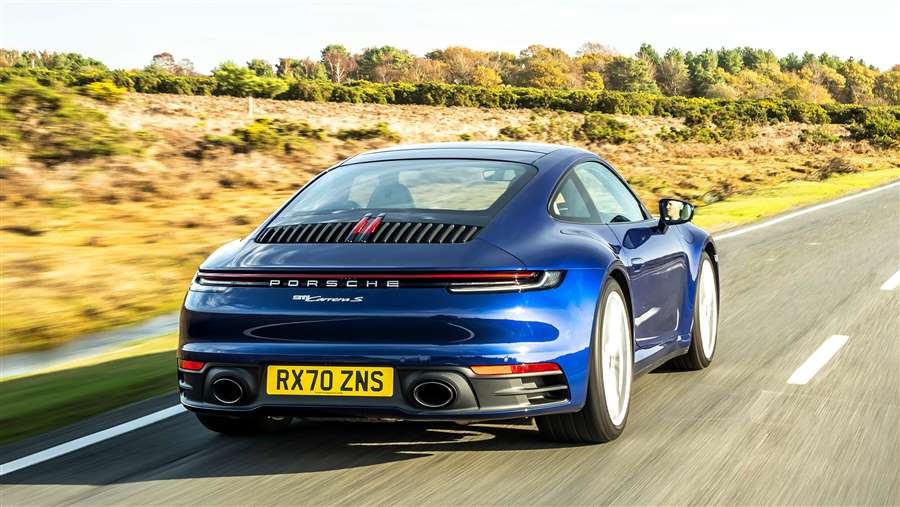
A few years back Porsche announced that it was going to drop the manual transmission not just from the regular 911 line-up but, shock-horror, from the far more focused GT3 versions as well. And at a stroke the world of the die-hard 911 enthusiast was thrown into a flat spin. They couldn’t believe their beloved 911 was no longer going to be available with three pedals in the foot-well and a gearstick between the seats.
Porsche, however, gave several extremely plausible reasons why it had reached this supposedly heretical decision. Without going into too much detail it pointed out that the 911 was faster, more efficient, more economical and, for an increasing number of approving customers, more engaging with a “PDK” dual-clutch gearbox. And for a while, that was that. The fast, manual 911 was no more.
But the enthusiasts continued to holler and eventually Porsche – to its credit – listened to them, even though they were in the minority. First came the 911R with a manual gearbox, then the GT3, and now we have the latest 992 Carrera S 911 available with a seven-speed manual as a no-cost option, tested here in rear-drive form.
In this case you lose 0.7 seconds going from 0-62mph versus the rear-drive Carrera S with a PDK gearbox, and 0.8 seconds during the sprint from 0-100mph (the manual takes 4.2 seconds to hit 0-62mph and 8.6 seconds to cover 0-100mph).
This is partly because you lose one ratio compared with the PDK, which means the ratios themselves are wider. But it’s also a consequence of simply not being able to shift as fast in the manual, up or down, and that’s where the science tends to throw a bit of a spanner in the works – because, subjectively, although the PDK is terribly impressive at what it does, it ain’t no substitute for stirring the lever and using the clutch manually.
Those with a good memory will recall that the previous generation 911 was also available with a manual gearbox for a short time, but the shift quality in that car wasn’t great, which somewhat defeated the object. This time, however, Porsche claims to have significantly improved the action of the shift with shorter, lighter, more precise throws, with seventh still on a dog-leg to the top right hand side of the gate.
And that’s very much how it feels when driving the new manual 911, albeit with one strange caveat which we’ll come to in a moment. What’s good about this 911 manual, no, what’s great about it is that it manages somehow to feel more like a traditional 911 on the move. For whatever reason, the car simply feels more compact and more agile when you’ve to dip the clutch and use your left hand to change gear.
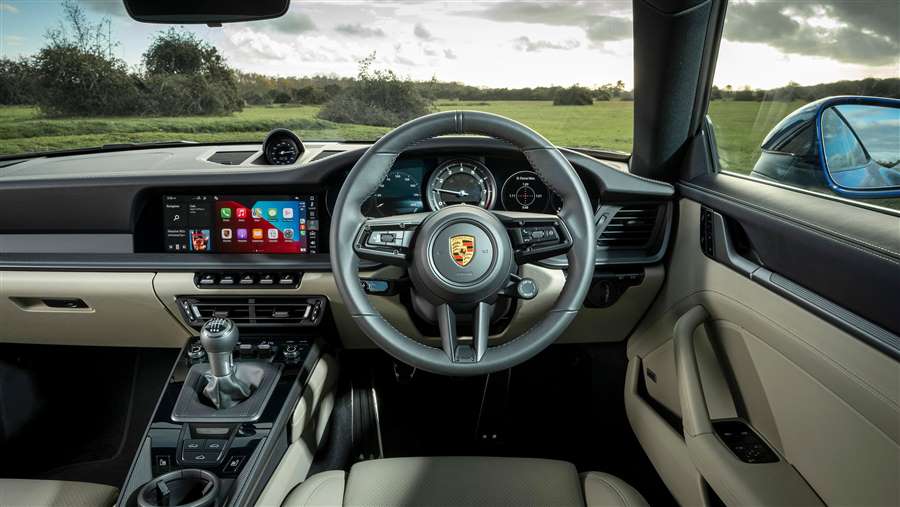
The manual is fractionally lighter than the PDK, but only by 35kg, so it’s highly doubtful this in itself would make much difference to what you feel when behind the wheel.
Instead it’s all about the subjective impression the manual 911 has upon you, the driver. In the most basic terms you simply feel more connected with this car when it has three pedals. And, yes, the shift quality itself is indeed a fair bit crisper and better than in the old manual, although as in the fruitiest versions of the new 718 Cayman and Boxster, the revs will blip themselves on downshifts if you select either Sport or Sport Plus mode via the rotational button on the steering wheel. Which is nice, yes, but also feels a bit automated within this context.
The manual even sounds better and feels every inch as fast as the PDK Carrera S if you select, say, third gear and accelerate from low revs all the way up to the red line. So in reality, and despite the differences in the claimed acceleration numbers, it doesn’t feel like you are losing out on any pure performance versus the otherwise mechanically identical PDK model.
And the caveat? For its own reasons Porsche has again made it impossible to select seventh gear from anything other than fifth or sixth gear when shifting up, same as in the old 991. There’s a mechanical block in the gate which means you can’t physically get seventh from a gear lower than fifth. Which obviously means you can’t go from fourth to seventh. This may sound entirely irrelevant but it’s actually quite annoying in practice because a four-seven is just what you want when entering a motorway, for instance.
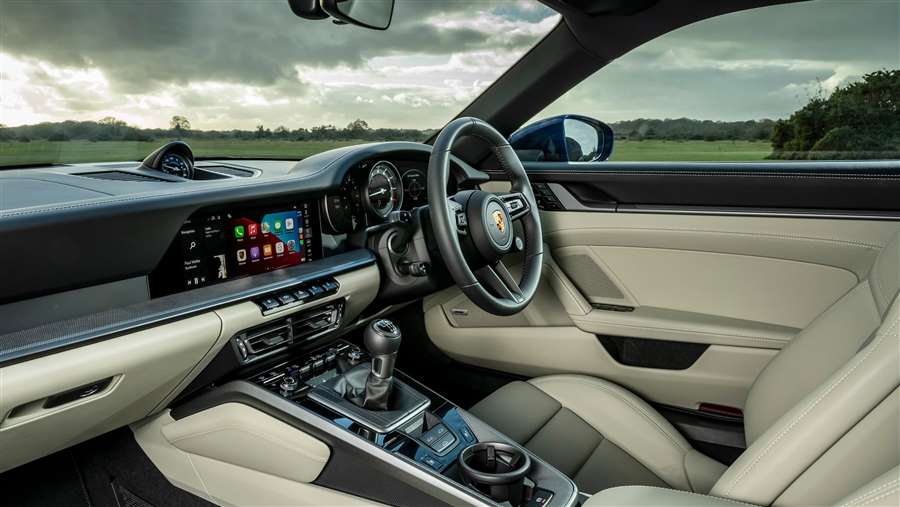
And what’s doubly odd is that you can, should you for some reason choose to, go from seventh to second or even first on the way back down.
Other than this, the manual 911 Carrera S is a very lovely car, one that feels more like a true-blue sports car than its equivalent with a dual-clutch auto. As such it broadens the 911’s appeal even further, catering for around 10 per cent of 911 enthusiasts who might otherwise have looked elsewhere. Including your author, who was once a PDK-only advocate.
Source: autoexpress.co.uk
The first details about the all-new Nissan Qashqai
One of the first and best-selling mid-size SUV models in the world is Nissan's "Qashqai". The third generation of this crossover is now in preparation, which, according to the announcements, will bring many changes in design and advanced technologies. As expected, electrified versions will be offered for the first time.
As a pioneer in the medium crossover segment, the "Qashqai" has been sold in Europe since 2007, where over 3 million units have been produced to date.
By the time it was replaced by the second generation in 2014, 17 direct competitors followed the "Qashqai" in the market with their models.
Despite the arrival of many European competitors, the first generation is sold in over 200,000 units per year during its lifetime.
Now the current model has as many as 26 direct competitors, among which are: "Renault Kadjar", "Ford Kuga", "Hyundai Tucson", "Mazda CKS-5", "Skoda karoq" and many others.
That is why it is very important for the new generation to continue at a successful pace and that is why its approach is very serious.
The new Qashqaii is based on the all-new CMF-C (Renault-Nissan) platform. It has been announced that it will use technologies from higher categories of cars, as well as that the proportions will be maintained. In terms of construction, the body will be lightened by as much as 60 kg, but also 41% stronger.
For now, it is known that it will be offered with front-wheel drive and 4 × 4, as well as with a 1.3-liter gasoline engine with mild hybrid technology, and Nissan's innovative e-POVER system, which contains an electric drive, is mentioned.
In conventional hybrid wheel systems, it is powered by an electric motor and a petrol engine, however, in the e-POVER system, the petrol engine is not connected to the wheels - only on a full battery.
The new "Qashqai" will be equipped with the next generation of ProPILOT for driving assistance, and the premiere is expected in the spring of 2021.
2013 Subaru BRZ First Drive
From the Archive: Subaru has the goods, presenting us with an exceptional, clairvoyant, delectable new rear-wheel-drive sports car.
Some things just don't make sense. Why is the food at Outback Steakhouse mostly Cajun style? Why can't Jennifer Aniston find true love? And why would Subaru and Toyota, two companies whose fortunes are built on mainstream sedan sales, collaborate on a rear-drive sports car?
The latter question is a bit easier to answer from the Subaru BRZ perspective. For one, Subaru has a currently breathing reputation for building sporty cars: They may sell in limited volumes, but the WRX and STI are nevertheless Subarus. And Subaru says that the engine in its BRZ, a 2.0-liter flat-four making its first public appearance in this car, will form the basis of its next turbo motor. For its part, Toyota says that its version of the car—to be sold as the Toyota 86 in Japan, as the GT 86 in at least the U.K., and as the Scion FR-S here—makes sense as a first thrust in its plan to again build sporty, fun-to-drive vehicles. Still, this isn't a car that most people saw coming from either manufacturer.
Cheese Fries, Please!
Then again, regardless of the boomerangs mounted on the walls and the "Chaze Frois, Plaze!" coasters, Outback Steakhouse's Alice Springs chicken is delicious—and devastatingly unhealthy, but that's beside the point. The BRZ is likewise delectable; our only gripe about the way it drives is a chassis that leads to understeer at the limit. That, however, is much less likely to give you a heart attack than a jumbo honey-mustard-marinated chicken bosom hidden under a pile of bacon and smothered in melted cheese. Indeed, right up until the nose starts to chatter off line, Subaru's new coupe is gifted with exceptional balance and clairvoyant reflexes.
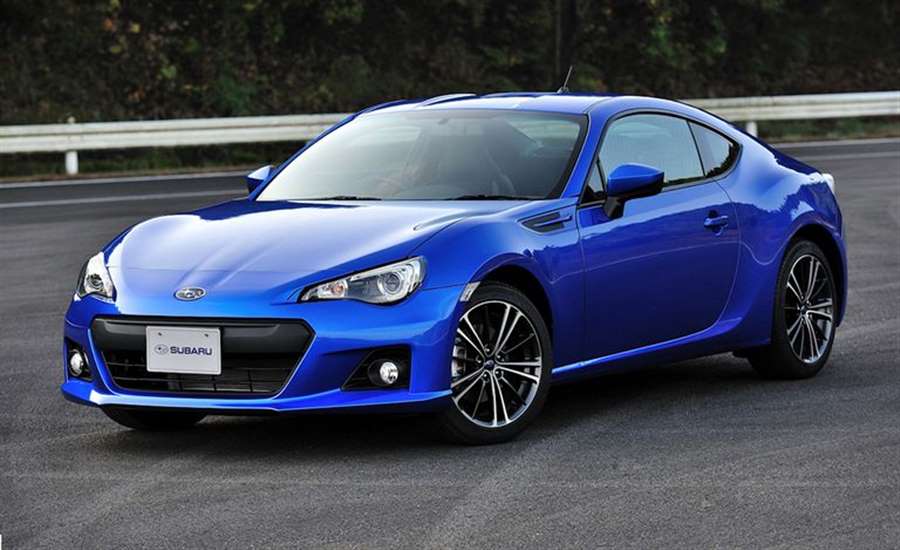
The understeer isn’t a deal breaker; with perfectly timed and moderated inputs (or with huge, pimp-slap jerks on the wheel and heavy stomps on the go pedal), it is possible to avoid it all together and turn it into delicious oversteer. When the rear end goes, even in the wet, the BRZ slides slowly and progressively. It's so easy to catch that you might find yourself fishing in your pocket for spare change with one hand while the other meters yaw around an off-ramp. (Subaru says that Toyota's suspension tune will vary slightly, a tad softer in the front and stiffer out back.) The brake pedal feels a little less wired than the rest of the car, but the binders wind the speedo back toward 0 in a hurry.
Conducting the chassis is steering that is more immediate than anything this side of the Lotus factory. Its heft is perfect for resisting unintentional inputs at the limit. Feedback falls short of perfection, but only slightly; blame the electric steering if you must. The electric motor assisting the BRZ's rack is mounted high up on the firewall, contributing to a slightly higher center of gravity but simultaneously shifting the front/rear weight balance a touch rearward.
In developing the BRZ, Subaru took an almost maniacal approach to weight and its management, keeping it low and evenly distributed between the car's axles. The company claims that 54 percent of this car's mass rides on the front wheels and 46 over the rear, and says that its center of gravity is right around 18 inches high. That latter figure rivals or beats the measurements for the Porsche Cayman and Mazda RX-8, among others.
Helping keep the mass snug against Mother Earth is the FA flat-four. Compared to the FB four found in other Subies, the FA's intake is 2.6 inches lower and the oil pan clings closer to the crankcase, allowing it to be mounted with its crankshaft centerline 2.4 inches lower. Amazingly, the engine is mounted 9.4 inches farther back in the chassis than an Impreza's four. A Subaru spokesman says the two engines share "maybe a few screws," but are otherwise completely separate pieces. We're told the weight difference between the two is negligibly in favor of the A. Placing the engine so far rearward of course helps balance the car, but it also precludes Subaru from fitting an all-wheel-drive system. The company says that it has no room for a turbocharger either, but after peering under the hood, we disagree. Besides, Subaru desperately needs something to tie this car to the rest of its lineup, and a turbocharged STI model would be the perfect solution. Although the BRZ doesn't need more power, it certainly could handle more. We're guessing that a turbo will be part of whatever mid-cycle updates this car sees in two or three years.
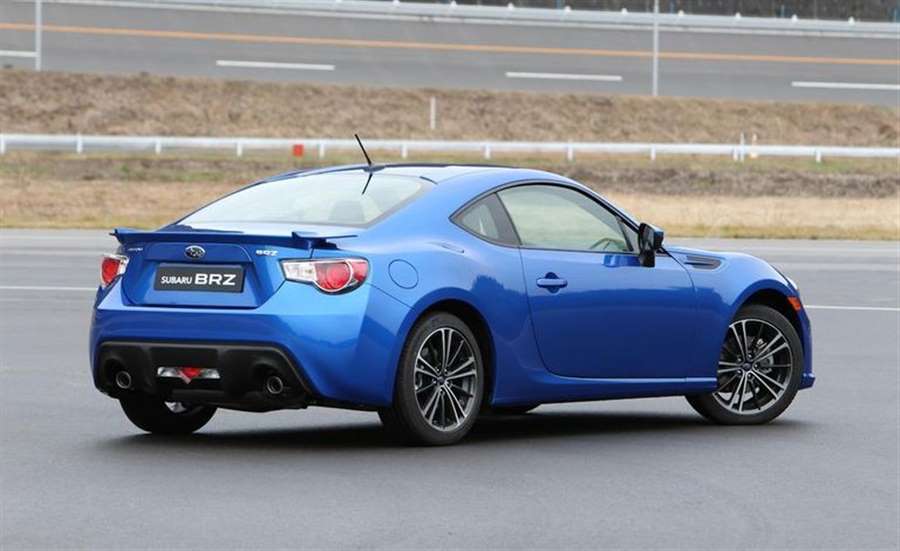
Despite a displacement difference of just 3 cc, the naturally aspirated FA and FB fours have dramatically different outputs. The B's 148 hp and 145 lb-ft of torque (as installed in the Impreza) lag 52 and 6 behind the A's 200 and 151—Subaru's stated output—while the A's 7400-rpm redline is 800 higher. Thank Toyota's fuel-injection setup, which squirts both via intake ports and directly into the cylinder—the system is Big T's lone contribution to the engine—and allows a crushing compression ratio of 12.5:1. "Crushing" is not a descriptor we'd employ for the acceleration, although we estimate a zero-to-60-mph time of around six seconds flat with the six-speed manual; add a couple of tenths with the six-speed auto. Top speed is said to be 143 mph. A resonator pipes sound into the cabin, and above 5000 rpm, there's enough noise inside the car that you'll need to scream to talk. Not that you'll be having much conversation. That said, we wouldn't call the quality of the sound unmistakable; it could be taken for a number of undesirable things. Having heard what aftermarket exhaust companies do for other Subaru flat-fours, though, we’re confident that they can coax a better voice out of this 7400-rpm screamer.
In spite of its higher output, the FA should still manage 30 mpg on the highway, according to Subaru. Underbody paneling helps keep a clean aerodynamic profile, although the company still hasn't decided if the treatment will be standard on all U.S. cars or only on higher trim levels.
Even the Weenies are Treated Well
As mentioned, two six-speeds are available, a manual and an automatic. Following our drive of the BRZ in Japan, the manual had us seeking a temple at which we might make an offering of thanks. The clutch pedal is a touch light—and a touch light on feel—but snaps to attention right off the floor and engages smoothly, and the stubby shifter snicks between gates with ease. Heretics who buy their sports cars with automatics will at least get a good unit. There are two modes in the Subaru: Drive and Sport. Wheel-mounted paddles are standard; in D, the transmission allows them to make gearchange suggestions but still upshifts at redline and downshifts when the driver floors the accelerator. In Sport mode, however, paddle commands are gospel—the way God's lazy, automatic-driving half-brother intended.
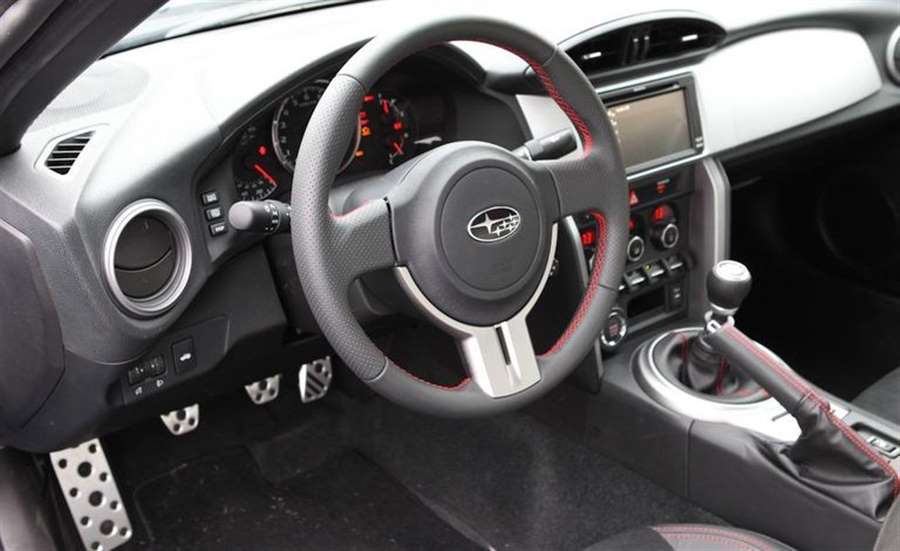
While most of the engineering and chassis work is Subaru's doing, the styling fell to Toyota. It apparently drew a basic coupe shape and—well, it must have seen it created something less than sultry but stuck with it anyway. It's good enough. The view from abaft is actually fairly exciting, with the slope of the greenhouse hesitating just slightly to form a decklid before tumbling into the rear fascia. Only the front fascia, badges, and maybe wheels separate the BRZ from its Toyota—and Scion—sibling. The suggestion of flares on the front fenders merely alludes to the muscular (some might say exaggerated) styling of the various concept cars, but the U-shaped view from the driver's seat over the scooped-out hood is at least unique. Visibility in all directions is much better than most sports cars.
Interior space, on the other hand, is just about par. It's fine up front, and average/shortish adults might even be happy in the back for shorter trips. Subie touts this as the shortest rear-drive 2+2 on the market. So it is. It also says that the car can accommodate a forward-facing child seat in the back. A rear-facing seat, on the other hand, would probably only fit if the parent riding shotgun rides shotgun in a car following behind. The trunk will hold just seven cubic feet of stuff, although both halves of the rear seatback fold for larger loads. According to Subaru, the space was designed from the beginning to hold a set of racing tires and a toolbox in this configuration, although that claim coincided with a PowerPoint slide entitled "Unexpected Utility"; we suspect that's probably the real story behind the tire-hauling ability. Or maybe that's why the tires are just 215 millimeters wide, as fitting a set in the car requires a two-tire stack.
The BRZ goes on sale in spring of 2012 as an early '13 model, at a base price we're now told will be around $25,000. Asked to make sense of the BRZ, a Subaru representative says, "It makes sense if you sell enough of them." In the U.S., Subaru thinks that 5000 to 7000 per year would be enough. Ultimately, though, a car this good doesn’t need to make sense: Its brilliance is all the explanation we need.
Source: caranddriver.com

